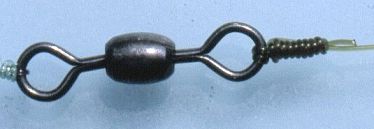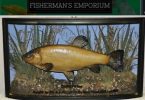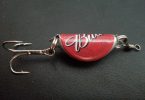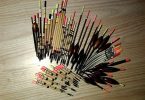I couldn’t help a wry smile the other day as I listened to a couple of anglers discussing the merits of their favourite brands of mono. What made the discussion so amusing was the fact that both monos, although sold under different labels, were identical! Fact is, there are comparatively few manufacturers of monofilament – and I am talking world-wide, here – so duplication is unavoidable. And no one should delude themselves that cost is a reliable indicator because it is by no means unusual for identical products, after being furnished with different brand labels, to be pitched at opposite ends of the price range.
Which line of thought – no pun intended – makes me consider other mono related areas of confusion, misunderstanding and misinformation.

There are lots of monos available, but fewer manufacturers than you might think.
KNOTS

We need to vary the number of coils to achieve optimum strength
We are all familiar with instructional knot-drawings accompanied by the information that such-and-such a knot will give ‘X’ percent strength. This is somewhat misleading because percentage knot-strength varies tremendously from one mono to another.
But it doesn’t end there.
Even proven knots such as the Clinch and the Grinner require customising by varying the number of coils – and not only to suit the brand, but also the line’s diameter. Likewise, seemingly straightforward advice like ‘first pass the line twice through the swivel eye’ is not universally applicable because some brands perform better if it is passed through the eye just once.
How do we know which knots are best suited to our preferred brand? Some distributors include recommendations with their products, and while such information provides a good starting point, it should not be taken as ‘gospel’ – there is no substitute for conducting your own tests.
The most consistent performer, incidentally, is probably the Palomar. It may not necessarily be the best knot, but it is invariably dependable.
It goes without saying that whatever knot is tied, the coils should be bedded down carefully, then lubricated with saliva (or better still, vegetable oil), and drawn tight slowly so as to avoid line damage due to knot-burn.
DIAMETER

Check diameter with a micrometer, and breaking strain with a spring balance.
Some monos are thicker than stated on the spool; a few are thinner. Some are both thicker and thinner because their diameter varies by as much as 0.05mm, giving them a sort of string-of-sausages profile! Most spool-label designations with regard to diameter, however, are fairly accurate.
Does it matter?
In the normal course of events, no. When fishing at close to mid range a difference of a few hundredths of a millimetre matters not one jot. It does, however, matter if fishing at long range because fine line casts further than thick line.
BREAKING STRAIN
Diameter needs to be seen in the context of breaking strain. Take two monos: one is labelled, ‘0.35mm, 12lb’; the other ‘0.35mm, 15lb’. It would seem that the 15lb version is the better choice because it offers extra strength without any increase in diameter. Experience suggests that this assumption is likely to be flawed because the seemingly lighter line might be underrated, resulting in there being no significant difference between them.
Further confusion occurs with IGFA rated lines which are guaranteed to break close to, but not in excess of the stated test strength.
The lesson to be learned from all this is that spool-label information should be used solely as a guide; precise diameter should be established with a micrometer, and breaking strain with a spring balance.
ABRASION RESISTANCE
Mono has quite good abrasion resistance – some brands better than others, of course. The best I have tested are Fox Soft Steel, Gold Label Pro-Gold, Sufix Synergy, Sufix Magic Touch and Nash Bullet. Monos with a high level of abrasion resistance are better equipped to cope with fibrous weed (which can be far more abrasive than most anglers realise), clay humps, submerged branches, wooden piles, mooring ropes, and possibly rusty steel cables.
On which subject – abrasion resistance, that is – I was intrigued to see an advertisement in a recent magazine which claimed that the distributor of a particular brand of mono was the first to appreciate the advantages of abrasion resistance.
Reluctant though I am to burst anyone’s bubble – and while I readily concede that who-said-what-first is hardly of earth-shattering importance – I nonetheless suggest that the aforementioned distributor look at page 12 in my book ‘Carp’ (Osprey Publishing Co.), where, under the subheading ‘Line’, he will read the following: "Features to look for include…….. good wet strength, not too stiff or springy, and lastly (and very important this) the line should be resistant to abrasion."
The book was published in 1974.
SHEAR RESISTANCE

A Quicksilver rubbing leader enabled fish to be safely landed despite sharp edged underwater rocks.
This is the characteristic which will increase the chances of taut, tensioned line ‘pinging’ across mussels or flints without parting. Unfortunately, no mono has this quality. If we need to contend with sharp topped bars, the best policy is to incorporate a braided Dyneema rubbing leader (Kryston Quicksilver being my choice).
ALL IN A TWIST

A couple of casts with a Gardner Spin Doctor will remove twist.
A couple of weeks before the first reference in advertisements to anti-twist line rollers
, the ‘innovation’ was disclosed to representatives of the tackle trade and the angling press at a special product launch. Carp-Talk’s Chris Ball was one of those in attendance; and when I found myself fishing alongside him a day or two later, he told me about it. Chris, as those who know him would expect, was characteristically enthusiastic. My response, as he will doubtless recall, was ‘Testicles!’ – or something very similar!
I publicly rubbished the notion in one of my Carpworld ‘Let Us Talk’ columns; and challenged reel manufacturers to explain how line-roller design could counteract a fundamental engineering principle – namely that if line leaves a spool, or is wound on it, at right-angles to its axis, twist will occur.
Thus far, no such explanation has been forthcoming.
I repeat – there is no way that the shape or size of a pickup roller can reduce line twist. The only practical way of mitigating the problem is to periodically have a couple of casts with a Gardner Spin Doctor.
Alternatively, of course, we could change to a multiplier or centre-pin…
SHELF LIFE
Most, perhaps all monos, deteriorate over time. Surprisingly, they vary considerably in this regard – while some brands show significant deterioration after just one year, others show little deterioration after two or even three years (I am talking here of line which is unused, and stored in the dark). The only way to be sure is to test it.
COLOUR

Long carp from long range!
Raw mono, if I may use the term, is a sort of off-white. To achieve browns, greens and what-have-you it has to be coloured. There are two ways of doing this: either the colour is added to the polymers prior to extrusion, or the off-white raw mono is treated in an acid bath and dyed. There are pluses and minuses to each process, but an effect common to both is that slight strength loss occurs.
Mono line is polished to give it a smooth surface (raw mono has a dull, matt surface) – which also results in a slight strength reduction.
No one, so far as I know, sells raw, uncoloured, non-polished mono. Even white (sometimes mistakenly called ‘clear’) mono is treated to make it white rather than off-white.
I’m not particularly fussy about colour, and use brown, green or white – depending what is loaded on my reels. An exception is when I am long range fishing in waters where I am in constant danger of having my lines ‘wiped out’ by water birds, when I like fluorescent yellow Ande Tournament because it scares the hell out of them, and ensures hassle-free fishing. It does not scare carp, however, because it is used in conjunction with a shock leader.
STRETCH
All monos stretch.
If nominal 12lb mono is subjected to a 5lb pull, it will stretch – depending on the brand – from 10 to 15 percent. If the pull is increased to 10lb, the lower and upper figures increase to 12 and 30 percent respectively.
I like the shock-absorbing quality of mono because I think it helps maintain secure hookholds and minimises the risk of mouth damage (this, incidentally, is part of the reason I am not a fan of main-line braid which, at breaking point loading, only stretches about three percent).
We have, over the years, seen the introduction of several ultra low diameter, pre-stretched monos. I’ve tried a couple, but found it difficult to obtain consistently strong knots. They have their fans, though – particularly for hooklinks when floater fishing.
For most fishing, I think monos offering average stretch are the best choice, although I prefer high stretch versions when fishery rules compel me to use barbless hooks – the inherent ‘bungee’ effect of a stretchy line undoubtedly helps maintain secure hookholds. Of the lines I tested, Maxima and Drennan Specimen Plus have the most stretch.
WET STRENGTH

Big Game and Bullet – my usual choice.
Some monos lose a percentage of their dry strength after submersion in water. I found in 48-hour soak-tests that five to ten percent was about average, although a few lost more than 20 percent. The worst performer lost a whopping 27 percent. I won’t identify the ‘rogue’ monos in case my test spools were untypical (old stock, for example); I shall, however, name those which scored well. Sylcast, Brent, Gardner/Insight GR60, Sufix Supreme, Maxima and Drennan Specimen Plus showed no strength loss at all. Big Game, Daiwa Sensor, Sufix Magic Touch, Ultima Tournament and Nash Bullet showed little or negligible strength loss.
A line manufacturer told me that monos which are acid-bathed prior to colour-dying are the most likely to suffer in this regard because they more readily absorb water.
STRESS
We are all familiar with the advice that we should replace line after it has been stressed – as when pulling for a break, for example. My tests suggest that this is probably unnecessary. Most stressed-to-breaking-point monos revert, after a ten minute rest, to their original breaking strain – or very close to it. Even the worst performer lost only 15 percent.
PRICE
Mono is very inexpensive to produce. The price we pay in the tackle shop does not reflect this fact, but that is because it has been inflated by various extras: spooling, labelling, advertising and the profit margins of those through whose hands it passes. But even accepting those extras, I think it is difficult to justify a price higher than œ10 per 1000 metre spool (or pro rata – some bulk spools hold more than 1000 metres).
FLUOROCARBON
Initially, I believe, popularised by fly fishermen. Now quite widely used for hooklinks – notably carp anglers’ stiff-links (that said – supple versions of fluorocarbon are available, too). Its primary virtue is its low visibility – a consequence of its refractive index being very close to that of water. An additional advantage is that its specific gravity is greater than water, so it sinks readily and lays flat on the bottom.
I have not used fluorocarbon for hooklinks as such, but I occasionally incorporate it i
n Concertina Twin Strand Links (see ‘Gravel Pit Carp’ for details).
Several references have been made in the angling press to the fact that fluorocarbon should not be placed between the lips (when moistening knots, for example). One report stated that this was because it had a lead component, while another implied that it was potentially carcinogenic. I can neither confirm nor refute these suggestions – hopefully an anglersnet reader or contributor can enlighten us? Meanwhile, I think it makes sense to err on the side of caution.
CHOICE
For general ‘workhorse’ use, line should be hard wearing, knot-friendly and reliable – characteristics embodied, to one degree or another, in all those mentioned in this feature.
My choice? It depends on the sort of fishing I am doing, but most of the time my reels are loaded with Nash Bullet or Berkley Big Game. I use Bullet because I played a major part in its selection for Nash Tackle (after testing numerous samples from the UK, the USA, Japan and Germany). And I use Big Game because, while not necessarily the best performer in the various categories, it is a good all-rounder. And I’ve caught so many carp on it, that I trust it implicitly.
FINAL COMMENT
For several years I was retained by Nash Tackle as a consultant, but at the beginning of 2001 – and by mutual agreement – Kevin Nash and I decided that our business association had run its course.
I am not associated with any other line distributor.
From the foregoing, it is clear that I have no vested interest in sales of any of the lines mentioned in this feature.
Jim Gibbinson








